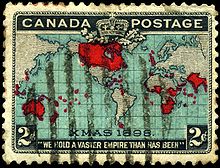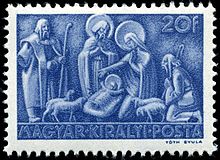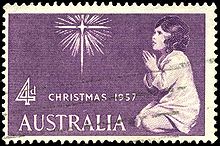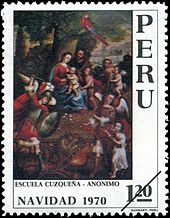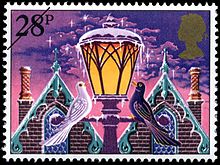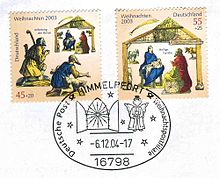- Christmas stamp
-
Many nations of the world issue Christmas stamps, postage stamps with a Christmas theme and intended for use on seasonal mail such as Christmas cards. These stamps are regular postage stamps, unlike Christmas seals, and are usually valid for postage year-round (in some countries they have a discounted value and are for use exclusively on Christmas cards). They usually go on sale some time between early October and early December, and are printed in considerable quantities.
Contents
History
It is a matter of some debate as to which is the first Christmas stamp. The Canadian map stamp of 1898 bears an inscription "XMAS 1898", but it was actually issued to mark the inauguration of the Imperial Penny Postage rate. The Christmas connection has long been reported to have been the result of quick thinking; William Mulock was proposing that it be issued on 9 November, to "honor the Prince" (meaning the Prince of Wales), but when Queen Victoria asked "what Prince?" in a displeased manner, Mulock realized the danger, and answered "Why, the Prince of Peace, ma'am".
In 1937, Austria issued two "Christmas greeting stamps" featuring a rose and zodiac signs. In 1939, Brazil issued four semi-postal stamps with designs featuring the three kings and a star, an angel and child, the Southern Cross and a child, and a mother and child. In 1941 Hungary also issued a semi-postal whose additional fees were to pay for "soldiers' Christmas". The first stamps to depict the Nativity were the Hungary issue of 1943. These were all one-time issues, more like commemorative stamps than regular issues.
The next Christmas stamps did not appear until 1951, when Cuba issued designs with poinsettias and bells, followed by Haiti (1954), Luxembourg and Spain (1955), then Australia, Korea, and Liechtenstein (1957). In cases such as Australia, the issuance marked the first of what became an annual tradition. Many more nations took up the practice during the 1960s.
By the 1990s, approximately 160 postal administrations were issuing Christmas stamps, mostly on an annual basis. Islamic countries constitute the largest group of non-participants, although the Palestinian Authority has issued Christmas stamps since 1995.
Designs
Although some tropical islands produce large-format Christmas stamps primarily intended for sale to stamp collectors, for the rest of the world, Christmas stamps are "working stamps" that will be used in large numbers to send greeting cards and postcards. Accordingly, the stamps tend to be normal-sized, and offered in one or a few denominations, for instance to cover differing domestic and international rates.
The choice of designs is highly variable, ranging from an overtly religious image of the Nativity, to secular images of Christmas trees, wreaths, Santa Claus, and so forth. A country may maintain a unified theme for several years, then change it drastically, in some cases seemingly to follow "fashion moves" by other countries. For instance, during the 1970s many countries issued Christmas stamps featuring children's drawings, with the young artist identified by name and age.
The choice of secular or religious designs is frequently a bone of contention; church leaders often see secular designs as diluting the meaning of the holiday, while postal officials fear that overly religious designs could lead their secular customers to avoid the stamps, leaving millions unsold, and even expose the postal administration to charges that they are violating laws prohibiting the promotion of a particular religion.
In the United States, annual discord over "secular" versus "religious" designs was resolved by issuing some of each; typically a group of 4-6 related secular designs, plus a Madonna and Child design. To avoid difficulties attendant upon contracting for original designs with a religious theme, the designs are based on Old Master paintings hanging in U.S. galleries, thus qualifying as depictions of art. The British Royal Mail resolves the difficulty by issuing "religious" and "secular" themed designs in alternate years.
Usage
The usual usage of Christmas stamps is to quickly apply them to a stack of Christmas cards to go out. In the age of email, Christmas stamps may represent some individuals' largest remaining use of stamps in a year, and it is not unusual to see "leftovers" appear on regular mail during the first months of the new year. In Australia where Christmas cards can be sent at a discount (currently 5c lower than the regular domestic rate, and up to 85c lower for international rates), these stamps will turn up on regular mail after Christmas with additional stamps to make up the correct rate.
Collecting
Christmas is a popular theme for topical collecting. Because of the quantities printed, almost all Christmas stamps are easy to come by and of negligible cost. Collecting challenges would be to get covers with apropos postal markings, such as a postmark on Christmas Day (not all post offices get the day off), from a location such as North Pole, Alaska, North Pole, New York, Santa Claus, Indiana, or Christmas Island, or slogan postmarks with a Christmas theme.
The Christmas Philatelic Club was formed in 1969 by Christmas stamp collectors, and has issued its bimonthly journal, the Yule Log since that time. A number of collectors treat Christmas collecting as a subcategory of religion on stamps.
Other holiday stamps
In Japan, there is a longstanding tradition of a New Years stamp. A number of Easter stamps have been issued, but these are clearly aimed at collectors.
The United States has occasionally issued stamps for New Years and Thanksgiving. During the 1990s, stamps for Kwanzaa, Hanukkah, Eid, and Chinese New Year have become a regular part of the holiday program, although the designs tend be used for several years, distinguishable only by a different denomination or year date.
Valentine's Day stamps are a more recent tradition in some countries.
References
- Waller Sager and Kathleen Berry, 75 Years of Christmas Stamps (1971)
- Kathleen Berry, Six More Years of Christmas Stamps (1977)
- Everleigh Foster, Christmas Stamps of the World (American Topical Association Handbook 120, 1990)
External links
- Christmas Philatelic Club homepage
- Christmas Stamps 1991-2009 (PDF file)
- "Secular Christmas stamps attacked", Telegraph July 2004
- Stamp Magazine online The first Christmas stamps
- Latest Christmas Stamps over the world (since 2004)
- Christmas Holiday Stamps (history of U.S. Christmas stamps thru December 2008)
Categories:- Christmas traditions
- Philatelic terminology
Wikimedia Foundation. 2010.


